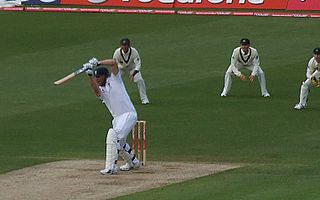
Bowling, in cricket, is the action of propelling the ball toward the wicket defended by a batter. A player skilled at bowling is called a bowler; a bowler who is also a competent batter is known as an all-rounder. Bowling the ball is distinguished from throwing the ball by a strictly specified biomechanical definition, which restricts the angle of extension of the elbow. A single act of bowling the ball towards the batsman is called a ball or a delivery. Bowlers bowl deliveries in sets of six, called an over. Once a bowler has bowled an over, a teammate will bowl an over from the other end of the pitch. The Laws of Cricket govern how a ball must be bowled. If a ball is bowled illegally, an umpire will rule it a no-ball. If a ball is bowled too wide of the striker for the batsman to be able to play at it with a proper cricket shot, the bowler's end umpire will rule it a wide.

Fielding in the sport of cricket is the action of fielders in collecting the ball after it is struck by the striking batter, to limit the number of runs that the striker scores and/or to get a batter out by either catching a hit ball before it bounces, or by running out either batter before they can complete their current run. There are a number of recognised fielding positions and they can be categorised into the offside and leg side of the field. Fielding also involves trying to prevent the ball from making a boundary where four "runs" are awarded for reaching the perimeter and six for crossing it without touching the grass.
In cricket, an umpire is a person who has the authority to make decisions about events on the cricket field according to the Laws of Cricket. Besides making decisions about legality of delivery, appeals for wickets and general conduct of the Game in a legal manner, the umpire also keeps a record of the deliveries and announces the completion of an over.

The wicket-keeper in the sport of cricket is the player on the fielding side who stands behind the wicket or stumps being watchful of the batsman and ready to take a catch, stump the batsman out and run out a batsman when occasion arises. The wicket-keeper is the only member of the fielding side permitted to wear gloves and external leg guards. The role of the keeper is governed by Law 27 and of the Laws of Cricket.

In cricket, a slip fielder is placed behind the batsman on the off side of the field. They are placed with the aim of catching an edged ball which is beyond the wicket-keeper's reach. Many teams employ two or three slips. A floating slip is sometimes employed, usually in limited over games, who patrols an area in the slip cordon that would ordinarily be occupied by more than one fielder. The slip cordon's distance from the batsman increases with the pace of the bowler; generally they will be marginally further away from the batsman than the wicket-keeper is. Because of the resulting geometry, spin bowlers generally have fewer slips in the cordon than a fast bowler would in an equivalent game situation. As fielding in the slips requires quick reflexes and sure hands, usually the most adept catchers in the team will make up the slip cordon. Most slip fielders are top order batsmen. Specialist slip fielders are sometimes called "slippers".

This is a general glossary of the terminology used in the sport of cricket. Where words in a sentence are also defined elsewhere in this article, they appear in italics. Certain aspects of cricket terminology are explained in more detail in cricket statistics and the naming of fielding positions is explained at fielding (cricket).

An all-rounder is a cricketer who regularly performs well at both batting and bowling. Although all bowlers must bat and quite a handful of batsmen do bowl occasionally, most players are skilled in only one of the two disciplines and are considered specialists. Some wicket-keepers have the skills of a specialist batter and have been referred to as all-rounders, but the term wicket-keeper-batter is more commonly applied to them, even if they are substitute wicket keepers who also bowl.
Short form cricket is a collective term for several modified forms of the sport of cricket, with playing times significantly shorter than more traditional forms of the game.

In cricket, batting is the act or skill of hitting the ball with a bat to score runs and prevent the loss of one's wicket. Any player who is currently batting is, since September 2021, officially referred to as a batter by ICC —regardless of whether batting is their particular area of expertise. Batters have to adapt to various conditions when playing on different cricket pitches, especially in different countries; therefore, as well as having outstanding physical batting skills, top-level batters will have quick reflexes, excellent decision-making skills, and be good strategists. Batter officially is a recent term introduced to cricket, although unofficially "batsmen" is still widely used.

In cricket, the boundary is the perimeter of a playing field. It is also the term given to a scoring shot where the ball is hit to, or beyond, that perimeter, which generally earns four or six runs for the batting team.

In cricket, a dismissal occurs when a batter's innings is brought to an end by the opposing team. Other terms used are the batter being out, the batting side losing a wicket, and the fielding side taking a wicket. The ball becomes dead, and the dismissed batter must leave the field of play for the rest of their team's innings, to be replaced by a team-mate. A team's innings ends if ten of the eleven team members are dismissed. Players bat in pairs so, when only one batter remains who can be not out, it is not possible for the team to bat any longer. This is known as dismissing or bowling out the batting team, who are said to be all out.

Cricket clothing and equipment is regulated by the laws of cricket. Cricket whites, sometimes called flannels, are loose-fitting clothes that are worn while playing cricket so as not to restrict the player's movement. Use of protective equipment, such as cricket helmets, gloves and pads, is also regulated.

In cricket, a run is the unit of scoring. The team with the most runs wins in many versions of the game, and always draws at worst, except for some results decided by the DLS method, which is used in rain-shortened limited-overs games when the two teams have had a different number of opportunities to score runs.
Baseball and cricket are the best-known members of a family of related bat-and-ball games. Both have fields that are 400 feet (120 m) or more in diameter between their furthest endpoints, offensive players who can hit a thrown/"bowled" ball out of the field and run between safe areas to score runs (points) at the risk of being gotten out, and have a major game format lasting about 3 hours.

Caught is a method of dismissing a batsman in cricket. A batsman is out caught if the batsman hits the ball, from a legitimate delivery, with the bat, and the ball is caught by the bowler or a fielder before it hits the ground.

A partnership is a term used in cricket, that usually refers to the two batters and the runs they score together, including extras. Two batters bat in a partnership, although only one is a striker at any time. The partnership between two batsmen will come to an end when one of them is dismissed or retires, or the innings comes to a close, usually due to victory being achieved, a declaration, a time or over limit being reached, the match being abandoned. In exceptional cases, if one of the original batters are injured, a player may run between the wickets on behalf of the injured batter. However, any runs scored by the injured batter will be recorded as being in the partnership of the two original batters. A partnership may also refer to two bowlers bowling from each end of the wicket.

Stumped is a method of dismissing a batter in cricket, in which the wicket-keeper puts down the striker's wicket while the striker is out of their ground. It is governed by Law 39 of the Laws of Cricket.

A cricket field or cricket oval is a large grass field on which the game of cricket is played. Although generally oval in shape, there is a wide variety within this: perfect circles, elongated ovals, rounded rectangles, or irregular shapes with little or no symmetry – but they will have smooth boundaries without sharp corners, almost without exception. There are no fixed dimensions for the field but its diameter usually varies between 450 and 500 feet for men's cricket, and between 360 feet (110 m) and 420 feet (130 m) for women's cricket.

Bat-and-ball games are field games played by two opposing teams. Action starts when the defending team throws a ball at a dedicated player of the attacking team, who tries to hit it with a bat and run between various safe areas in the field to score runs (points). The defending team can use the ball in various ways against the attacking team's players to force them off the field when they are not in safe zones, and thus prevent them from further scoring. The best known modern bat-and-ball games are cricket and baseball, with common roots in the 18th-century games played in England.

Cricket is a bat-and-ball game that is played between two teams of eleven players on a field at the centre of which is a 22-yard (20-metre) pitch with a wicket at each end, each comprising two bails balanced on three stumps. Two players from the batting team stand in front of either wicket holding bats, with one player from the fielding team bowling the ball towards the striker's wicket from the opposite end of the pitch. The striker's goal is to hit the bowled ball with the bat and then switch places with the nonstriker, with the batting team scoring one run for each exchange. Runs are also scored when the ball reaches or crosses the boundary of the field or when the ball is bowled illegally.



















